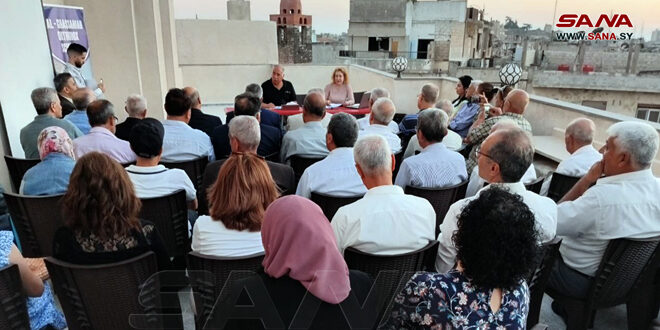On the ninth anniversary of the martyrdom of archaeologist Khaled Al-Asaad, the Syrian Scientific Historical Society, in cooperation with the Ghassanian Orthodox Schools in Homs, organized a symposium in memory of the martyr Khaled Al-Asaad, a Syrian archaeologist and the head of antiquities at the ancient city of Palmyra, with the participation of a group of writers and friends.
With the presence of family and officials in the main hall of the schools administration in Bustan Al-Diwan neighborhood, the symposium was moderated by the head of the board of directors of the Society in Homs, Dr. Fayrouz Youssef, who described the martyr as not the story of a man carrying a shroud on his shoulder and a story told by time, but rather the legend of a man who died for the homeland. She noted that the purpose of killing the martyr Al-Asaad at the hands of enemies of humanity was not to destroy history, but rather to destroy those who preserve and protect it.
The writer Issa Ismail presented pictures from his memory and his meeting with the martyr Al-Asaad on more than one occasion, explaining that Al-Asaad was loyal to his country until his last breath, as he contributed to the restoration of 400 ancient columns and the discovery of dozens of numbers in Palmyra. He had a language that allowed him to summarize his ideas and convey them to the young and old and to different cultural levels in his talk about the antiquities of Palmyra and its treasures.
The poet Hassan Kattoub recited a poem of mourning for the martyr Al-Asaad, addressing him as the keeper of the buried secret of our human civilization, treasures and history. He also recited the poem “I am the Syrian” in which he expressed his pride and honor in the ancient Syrian civilization.
As for the son of the martyr Al-Asaad, Muhammad, he spoke about his father’s love for Palmyra, which he would not exchange for the countries of the world.
Engineer Nabil Musa, the martyr’s friend, spoke about Khaled Al-Asaad’s thought and project to develop human resources and the archaeological institution, excavate more submerged antiquities, and translate many books from Palmyra’s Aramaic language, indicating that the martyr Al-Asaad was the defender of the treasures of Palmyra until the last moment of his life.
Inas Abdulkareem

